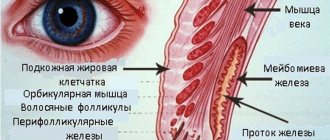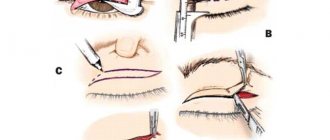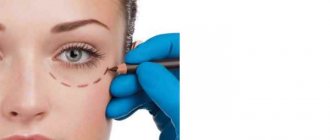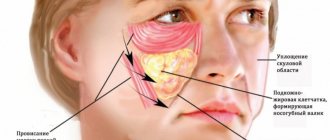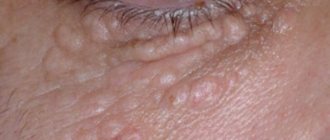Indications and effectiveness
After 30 years, the production of hyaluronic acid and metabolic processes at the cellular level slow down. Since the skin in the area of the lower and upper eyelids is several times thinner than the rest of the skin covering our body, age-related changes appear in this area first.
To make your look more open and your face attractive, it is recommended to undergo plastic surgery - a lower eyelid lift. Blepharoplasty will help:
- remove a hernia in the infraorbital region;
- eliminate small wrinkles called “crow’s feet”;
- raise the corners of the eyes;
- cope with congenital or acquired defects under the lower eyelid;
- make tear troughs less visible;
- eliminate both diseases and age-related bags under the eyes.
Lower eyelid blepharoplasty is recommended for all those who want to look younger, have congenital defects or vision problems. The operation is performed even on teenagers who do not want to put up with their unattractiveness.
The procedure is performed under general or local anesthesia. The question of prescribing anesthetics is decided by the surgeon together with the anesthesiologist, taking into account individual intolerance, contraindications to general anesthesia and the duration of the operation itself. If you need to do a circular eyelid lift, then you cannot do without general anesthesia.
The operation does not last long - from 40 minutes to 2.5 hours. In modern clinics, under favorable circumstances, you can be discharged on the day of the procedure.
You should know! Some women mistakenly believe that lower eyelid blepharoplasty can get rid of dark circles under the eyes. Unfortunately, such an operation will not be able to eliminate hematomas. It only involves removing the fat layer, eliminating wrinkles and changing the shape of the eyes.
When is lower eyelid blepharoplasty allowed? There are no restrictions in this regard. In case of age-related changes, as a rule, a similar procedure is resorted to after 40 years. It is at this age that problems with facial skin become clearly visible.
The effectiveness of the operation can be assessed after 1.5–2 months, when the swelling and hematomas disappear and the sutures are completely healed. In most cases, patients are satisfied with the result. The incision sites are completely invisible, so you won’t have to apply tons of makeup under the lower eyelid.
The following before and after photo demonstrates how blepharoplasty eliminates bags under the eyes. As you can see, rejuvenation is evident.
Repeated lower eyelid blepharoplasty is permitted after 10 years. In cases where a surgeon’s mistake was made or the rehabilitation period resulted in complications, another operation is resorted to. This type of surgical intervention is quite complex, because due to tissue scarring, the incision must not be made according to the standard pattern. In addition, tissue deficiency affects the quality of the operation itself. As a rule, repeated blepharoplasty is performed in case of asymmetry, non-closure of the eyelids or in the presence of a “round eye”.
Results of fat-sparing blepharoplasty
Before fat-saving blepharoplasty, each patient must undergo a comprehensive medical examination and tests. During the consultation, the plastic surgeon should talk about the features of the procedure and the stages of the operation. Using modern technologies, he can simulate the result of blepharoplasty.
We recommend: What is hardware blepharoplasty?
Photos before and after plastic surgery show a natural and youthful appearance of the face - there is no effect of tightness and a skeletonized eye, which, although many patients like, creates an unnatural effect. The stitches are not visible - they turn white after a few months, and even the patient himself will not see them.
This operation can be performed not only on women, but also on men – they also suffer from the accumulation of fatty tissue in the area under the eyes. The anti-aging result lasts up to 7 years, and to prolong it it is necessary to monitor your health and skin. It is necessary to eat properly and not eat foods that cause swelling.
YouTube responded with an error: The request cannot be completed because you have exceeded your quota.
Rate this article:
- Related Posts
- How is CO2 laser blepharoplasty performed?
- Rules for non-surgical facelift with Margarita Levchenko
- What is sutureless blepharoplasty?
- How to perform blepharoplasty at home?
- What is hardware blepharoplasty?
- What is plasma blepharoplasty?
Preparatory stage
Have you decided to have lower eyelid blepharoplasty? Then be prepared to undergo a number of tests to determine the state of your health:
- general analysis of urine and blood;
- blood for biochemistry;
- blood for hepatitis, HIV infection, syphilis;
- fluorography;
- coagulogram;
- tests for the occurrence of allergic reactions to anesthesia;
- ECG.
You will also be referred to a consultation with an ophthalmologist to rule out eye diseases, and an anesthesiologist to prescribe the correct anesthesia that best suits your body.
When is the best time to go under the surgeon's knife? The time of year does not matter, but it is preferable to agree to the operation in the warm season. This will prevent hypothermia.
If surgery is scheduled, you are prohibited from:
- drink alcohol and smoke within 2 weeks;
- 1.5 weeks before, take any medications that affect the state of the circulatory system - Ibuprofen, Aspirin, Diclofenac, Paracetamol, etc.;
- 3 days before surgery, apply decorative cosmetics to the eyelids and face, as well as use perfume or deodorant;
- Drink water and eat food 8 hours before.
You should know! Fat-sparing blepharoplasty may be prescribed for medical purposes. For example, when chalazions with a thickness of more than 5 mm form, their immediate removal is required. Such manipulations are performed to minimize the risk of development into malignant neoplasms.
Until you agree to the operation, in modern clinics they show the expected result on a computer. The photographer will take a portrait photo, which will be processed with a special program.
Types of surgery
There are different types of lower eyelid blepharoplasty:
- Transconjunctival. It involves making a small incision along the conjunctiva and removing excess fat through it. It is considered the safest option with a minimal rehabilitation period. As a rule, it is used to remove hernias in young people whose dermis is elastic and does not have wrinkles.
- Traditional or classic blepharoplasty of the lower eyelids. It is used when it is necessary to remove not only a hernia, but also a certain part of the skin. The incision is made just below the eyelash line. Upon completion of all necessary manipulations, stitches are applied.
- Laser (seamless) blepharoplasty. Used in modern plastic surgery clinics. The cuts are made not with a scalpel, but with a laser beam. The risk of harmful effects on the cornea and eyeball is minimal. In addition, due to the sealing of capillaries, the restoration of the skin occurs very quickly. The procedure does not take more than 50 minutes.
- Blepharoplasty with canthopexy offers a complex effect on the eyelids - removing bags, excision of the overhanging eyelid and changing the shape of the eyes. Canthopexy is a contour plastic surgery aimed at tightening muscles and correcting the lower eyelid.
How many times can blepharoplasty be done? The number of transactions is limited. Subsequent surgery can be performed after 12 years.
Distinctive features of fat-saving plastic surgery from the traditional method
Traditional or classic blepharoplasty is the excision and removal of fat and skin tissue in the eyelid area. And with fat-sparing blepharoplasty, fatty tissue is not excised, but distributed over the areas of the eyelids that most show age and need to fill the lost volume.
The main disadvantage of classical eyelid correction is the elimination of fatty tissue, which, if properly distributed into the problem area, could rejuvenate the look and expression of the eyes. The eye is surrounded on all sides by fatty hernias and, having lost such a fatty layer, the skin tightly fits the eyeball, resulting in sagging skin and retraction of the upper eyelid.
We recommend: How to perform non-surgical blepharoplasty with mesoeye c71?
In addition, a tear trough is formed, and as a result, the eye area operated on by the traditional method needs to be filled with fatty tissue. To prevent this from happening, it is necessary to do fat-saving blepharoplasty of the eyelids. Traditional eyelid surgery is an excellent way to correct eyelids, but almost all patients have the same eye expression.
You can see the differences between traditional and classic blepharoplasty from representatives of domestic and foreign cinema, who are increasingly turning to plastic surgeons to rejuvenate this area of the face. Many European celebrities were able to rejuvenate their look, but at the same time maintain the natural shape of their eyes, and domestic stars have the effect of sunken eyelids.
Operating stages
Traditional surgery to remove fat and skin goes through the following stages:
- At the preliminary stage, the doctor makes markings with a special marker, which will help him perform the procedure correctly. The marker is used so that after excision of the skin there remains 10 mm to the eyelash growth line.
- The patient is transferred to a sitting position. The doctor assesses the symmetry of the incisions.
- An incision is made just below the lash line.
- A scalpel is used to cut the muscle.
- The surgeon eliminates the fat layer.
- Unnecessary skin is cut off.
- Upon completion of all the above manipulations, the incision is sutured with special threads. A sterile dressing is applied.
The following video demonstrates how lower eyelid blepharoplasty is performed.
The outcome of the operation will not always be comforting. You must understand that when going under the surgeon’s knife, there is always a risk of an incorrect operation or serious complications. In this case, repeated surgery, called correction blepharoplasty, will be required. In most cases, it is carried out after 6 months.
Rehabilitation period
After the operation is completed, you should remain under the supervision of medical workers for several more hours. After this time or the next day, you will be discharged from the hospital. On the fifth day, you definitely need to see a surgeon. If everything is fine with your recovery, your stitches can be removed that day.
Important point! Follow your surgeon's recommendations strictly. Change cooling dressings frequently to reduce swelling and relieve bruises more quickly. Don't forget to put anti-inflammatory drops in your eyes as prescribed by your doctor.
Typically, the surgeon prescribes the use of antibacterial eye drops Sofradex, Dexamethasone, Dexon or Actovegin eye gel. Levomekol or Heparin ointment can also be used, but the risk of allergic reactions with these drugs is higher. On days 12–17 after removal of the suture, it is recommended to use hydrocortisone ointment for better scarring.
Blepharoplasty by day involves recovery within 3 weeks. Swelling and hematomas disappear within 5–7 days. For women over 50 years of age, this period extends to 13–15 days. After the sutures are removed, the incision line heals within a few weeks.
Cost of the procedure
How much does blepharoplasty cost? This question interests many women and men.
Blepharoplasty of the lower eyelid is a completely affordable rejuvenation option. On average, you will pay 80 thousand rubles for surgical removal of bags and wrinkles under the eyes.
The cost of the operation is affected by:
- choice of anesthesia;
- the complexity of the operation itself;
- surgeon experience;
- prestige of the clinic.
Of course, if you turn to experienced Moscow specialists who specialize in blepharoplasty, you will pay about 130–150 thousand rubles. But since lower eyelid lift surgery is an important and responsible step with risks to your beauty, it may be better to save up a little and trust real professionals.
The cost of blepharoplasty directly depends on the degree of complexity of the operation. If you only need to remove excess skin (grade 1), then you can invest 40 thousand rubles. For degree 3 of complexity you will have to fork out a little - 50-55 thousand rubles. Prices for lower eyelid surgery with changes in eye shape start at 80 thousand rubles.
The operation must take place in medical centers - clinics that specialize in plastic surgery. Before making an appointment with a surgeon, be sure to find out whether the medical institution has permission to perform this type of operation.
Blepharoplasty
September 29, 2020 Plastic surgery
Eyes are our “calling card”. Age-related changes in the periorbital region develop much earlier than in other zones. The first manifestations of these changes are a “tired look,” the appearance of a nasolacrimal trough, and bags under the eyes. Unfortunately, despite the rapid development of therapeutic cosmetology technologies, correction of age-related changes in the periorbital area can only be carried out surgically.
What can surgeons offer today?
There are several types of operations to rejuvenate the periorbital region, and the choice of method depends on what specific changes the patient comes to consult with the surgeon with.
Classic blepharoplasty
involves skin incisions in the area of the upper eyelids, located along the natural folds, in the area of the lower eyelids, under the ciliary edge, removal of excess skin, as well as protruding fatty tissue. Internal cosmetic sutures are placed on the incisions. Below are the stages of upper and lower eyelid surgery.
Transconjunctival blepharoplasty
- made with an incision in the conjunctival (internal) cavity of the eye. Through this incision the hernial sacs are removed.
An operation with such access is not performed in cases of pronounced excess skin or an abundance of fine wrinkles.
Both of these operations can be combined with the Loeb operation
, in which fatty tissue is not removed, but moved in such a way as to fill the nasolacrimal groove with it.
Another modification of blepharoplasty is aimed at strengthening the ligamentous apparatus of the eye. The weakening of the external ligaments is accompanied by drooping of the corners of the eyes, and the face takes on a sad expression. In this case, a so-called canthopexy
, tightening and strengthening ligaments. Due to this, the corner of the eye is raised and the lower eyelid is strengthened.
For drooping eyebrows, blepharoplasty is complemented with a brow lift or browpexy.
, which involves suspending the brow fat pad in a higher position, which creates an open look. By the way, forehead wrinkles in many patients appear precisely because of the habit of constantly raising their eyebrows, which they get rid of after surgery.
And finally, all these operations can be combined with a deep lift of the upper
and
the middle zones
of the face, in which the forehead, temporal region, and zygomatic region are tightened. In this case, incisions are made in the scalp of the temporal region, measuring 4-5 cm.
The advantage of this operation is a long-term stable result, as well as the fact that incisions on the eyelid can be avoided without reducing the volume of the operation.
The surgeon decides which method is right for the patient during the consultation.
It should be noted that 50% of the success of the operation depends on the chosen method and the volume of surgical intervention.
For example, a 35-year-old woman comes and asks for “lower eyelid surgery” and “removal of bags.” On examination, it is noted: minor hernias of the eyelids, drooping of the outer corner of the eye and tail of the eyebrow, deepening of the nasolacrimal groove. If this patient undergoes traditional eyelid surgery, the hernial sacs will be eliminated - “the order is completed.” But the woman will not look younger, she simply will not have hernial sacs, and the absence of hernial sacs in itself is not a sign of youth. An operation is required for comprehensive rejuvenation of the upper area of the face (raising the eyebrows and the outer corner of the eye, smoothing the nasolacrimal trough, removing hernial sacs, eliminating wrinkles), only in this case can the result that the patient desires, without realizing it, be achieved. Therefore, the main task of a plastic surgeon is to see what the patient really needs to do and explain to her the expected effects as a result of a complex and individual operation.
The operations are performed by Tvauri Anna Romanovna
– Candidate of Medical Sciences, full member of the Society of Plastic, Reconstructive and Aesthetic Surgeons (OPRESH), with 10 years of experience in plastic surgery.
How to get to us:
From Art. m. "Rizhskaya":
Trolleybus 18, 42 or bus 84 (or minibus of these routes) to the stop “ul. Obraztsova".
From Art. metro station "Belorusskaya" (towards Rizhsky station):
Trolleybus 18 or bus 12 to the stop “ul. Novosuschevskaya".
From Art. metro station "Savelovskaya" (towards Rizhsky station):
Trolleybus 42 or bus 84 to the stop “ul. Novosuschevskaya".
Contact phone numbers:
(495) 776-20-25,
Our address: Moscow 2nd Yamskaya, 11\13
Restrictions after surgery
At home during the postoperative period, follow these rules:
- do not apply decorative cosmetics and your usual creams during the first week;
- stop wearing contact lenses, reading and actively watching TV;
- Avoid direct eye contact with sunlight, so wear sunglasses for several weeks;
- For the entire period of rehabilitation, stop drinking alcohol and smoking;
- try to eat light food, which will help the body quickly restore the strength lost during surgery;
- Do not, under any circumstances, tear apart the seams yourself or remove dried crusts, and in the first 2 days do not touch your face with your hands at all;
- At first it is recommended to sleep on your back;
- to maintain muscle tone, rapid correct scarring and eliminate some skin problems, you should carry out eye exercises prescribed by a specialist;
- Strong physical activity, which can lead to hemorrhage, is contraindicated;
- At first, try to avoid contact with tap water; you can only wash your face with boiled water.
Important point! Cosmetic and therapeutic procedures such as lifting, lymphatic drainage massage, rough peeling and Botox injections can be performed only after 1.5 months.
Postoperative rehabilitation
Due to some features and methods of eyelid surgery, the recovery period lasts from 7 to 10 days. Do not be afraid of eye irritation from the suture material and discomfort. Swelling may also be observed, which goes away on its own after 2-3 weeks. In the postoperative period and to prevent complications, the following recommendations should be followed:
- in the first week you need to limit physical activity;
- for 5-7 days you cannot read, use computer equipment, or watch TV;
- for 2 weeks you cannot sunbathe in the sun or go to the solarium;
- You cannot use contact lenses for up to three weeks;
- for a month you need to limit yourself to taking a hot shower, visiting the sauna and swimming pool;
- for three months you must wear sunglasses to protect your eyes from ultraviolet radiation;
- Make-up should not be applied until complete rehabilitation after surgery.
Contraindications
Because you will be under anesthesia and make an incision, your doctor will ask for your medical history. You will need to bring a medical card and undergo some examinations, for example, donate blood for biochemistry and do an electrocardiogram of the heart.
An incision with a scalpel or laser will be made in the lower eyelid area; therefore, such surgical intervention is prohibited without the prior permission of an ophthalmologist.
Contraindications:
- glaucoma and cataracts;
- blepharospasm and excessive dryness of the eye;
- conjunctivitis;
- bearing a child and the period of breastfeeding;
- heart problems, as well as previous heart attack or stroke;
- the presence of serious dermatological diseases on the face;
- recent use of antibiotics;
- elevated temperature;
- just had the flu or acute respiratory infections;
- increased eye pressure;
- oncology and HIV;
- stage of exacerbation of chronic diseases, for example, herpes;
- serious abnormalities in the functioning of the kidneys and liver;
- hypertension;
- blood incoagulability;
- autoimmune diseases;
- diabetes.
During your consultation with a surgeon, we recommend that you answer the questions posed truthfully. If you want to hide any illness, after the operation there may be disastrous consequences for your health.
Do you know if you are allergic to the prescribed anesthesia? Do a special test. In modern clinics, the anesthesiologist will definitely offer you a similar procedure.
A circular eyelid lift is the best way to restore youth to your face
A beautiful eye contour is the dream of any woman, but over time, the upper eyelids begin to sag inexorably, and bags form under the eyes. The solution may be a circular eyelid lift - the most radical method of rejuvenation.
A circular eyelid lift includes one-time plastic surgery of both the upper and lower eyelids. This method of surgical intervention is considered the most productive, as it leads to the best results. As a result, the patient gains an open look without wrinkles, sagging eyelids and bags under the eyes.
While working on the patient's new appearance, the surgeon makes a series of incisions in the natural folds of the eyelid and in the subciliary area of the lower eyelid. Working through these incisions, the doctor removes any hernias that have arisen, eliminates or redistributes fat pads under the eyelids,, if necessary, lifts and fixes the muscles under the eyelids, and also excises excess skin flaps.
Since the incisions are located in the natural folds of the skin, the small scars remaining after a circular eyelid lift are practically invisible, and over time they completely resolve and become invisible.
Complications
Unfortunately, complications after lower eyelid blepharoplasty are very difficult to avoid. Your body must respond to surgery in any case. If side effects occur immediately after the procedure, you need to wait a little, because, as a rule, they will disappear after 5-7 days.
If complications appear some time after the operation or linger for a long time, contact a plastic surgery clinic to eliminate them.
For example, swelling that occurs immediately after surgery is not a complication. In a few days the swelling will go away. But if swelling under the eye persists for a week, immediately consult a surgeon.
Edema leads to deterioration of vision. They can cause diplopia (double vision) and even headaches. To eliminate swelling, it is recommended to apply ice cubes to areas with swelling. They should be wrapped in a plastic bag and covered with a sterile bandage. It is forbidden to hold ice for more than 2 minutes. When your stitches are removed, apply cotton swabs soaked in a decoction of chamomile, string, St. John's wort or calendula.
Hematomas are much more serious than swellings. Some of them go away on their own, and some require additional intervention - taking a puncture. The worst thing is when the hematoma affects the mobility of the lower eyelid and provokes protrusion of the eye. In this case, you cannot do without an additional examination and consultation with an ophthalmologist.
Other side effects:
- pain, burning and stinging in the eye area;
- inversion of the lower eyelid followed by drying out of the eye, or scientifically called ectropion;
- tearing, which is associated with displacement of the tear openings or abnormal scarring;
- sutures come apart, requiring re-application;
- formation of seals (cyst or lump) after blepharoplasty of the lower eyelids;
- non-closure of the eyelids, requiring repeated surgery;
- asymmetry of the eyes due to irregular scarring.
It should be noted that serious complications with blepharoplasty are very rare. Of course, the reason for this could be:
- violation of sterility during the operation;
- medical error in making an incision, eliminating fat, touching capillaries or improper suturing;
- a more pronounced nasolacrimal groove if fat-saving blepharoplasty was not performed;
- individual reaction of the body;
- non-compliance with care rules during the recovery period.
As you can see, if complications occur late, they require surgical intervention. Therefore, we strongly recommend choosing a trusted clinic and experienced surgeons. It is best to pay attention not to paid reviews on the Internet, but to the advice of your friends who have already had an eyelid lift.
If a surgeon makes mistakes, it is not necessary to immediately go under the knife. There is a whole range of cosmetic procedures that help cope with problems that arise after unsuccessful blepharoplasty. For example, due to the removal of a large amount of fat, the eyes may become sunken. The lost volume can be easily replenished by introducing fillers into the deep layers of the epidermis.
Possible consequences
After blepharoplasty, some complications are possible, which can arise for various reasons:
- subcutaneous hematoma - eliminated without surgery, by puncture;
- tearing - possible as a result of displacement of the lacrimal openings;
- Diplopia (a visual disorder in which visible objects appear in two) is likely due to disruption of the motor muscles and appears several hours after surgery. Symptoms disappear 2–3 weeks after plastic surgery;
- conjunctivitis - appears due to surgical intervention. Eliminated with the help of drops prescribed by a doctor;
- inversion of the lower eyelid - appears with excessive excision of tissue;
- infectious complications - possible due to non-compliance with hygiene standards during plastic surgery;
- asymmetry is a consequence of poor-quality surgery;
- blepharoptosis is a drooping eyelid that occurs if a nerve is damaged during plastic surgery.
Conjunctivitis may appear after eyelid correction
Can the procedure affect visual acuity? This question is answered by the chief physician and leading plastic surgeon of the aesthetic medicine clinic “Time of Beauty”.
We work only with skin and fabrics, without in any way touching the eye itself. I think vision can only improve if there was severe drooping of the upper eyelid, and after surgery the patient can look at the world with wide eyes.
Otari Gogiberidze
https://vrkr.ru/ru/news/5_mifov_blefaroplastica
Eyelid correction with plastic surgery will help achieve a clear, open look
Alternative options
As an alternative, you can try to eliminate lower eyelid wrinkles using hyaluronic acid fillers (biorevitalization) or undergo a special massage course. But the effect of such procedures will be delayed for a maximum of 6 months. If you have hernias (a bag under one or the other eyelid), drooping corners of the eyes or asymmetry, then you will not be able to achieve a positive result with injections and massage.
You should know! Unlike circumferential lifting and eyelid resection, lower blepharoplasty is considered safer. It involves a quick recovery period and a low likelihood of complications.
In some cases, surgeons recommend blepharoplasty with canthospexy, which involves not only removing bags under the eyes, but also correcting the corners of the eyes. This operation is characterized by an amazing rejuvenating effect.
How to solve the problem of drooping eyelids and drooping eyebrows?
It is not always possible to eliminate all age-related changes in the upper part of the face using traditional blepharoplasty, since simple excision of excess skin and fatty hernias does not give the desired result. The feasibility of performing traditional blepharoplasty can be called into question within a year due to the appearance of the effect of an operated sunken eye and drooping of the outer edge of the eyebrow.
It is possible to eliminate facial wrinkles, lift eyebrows, and form a natural beautiful fold of the upper eyelid only with the help of a complex operation. In a trusted clinic, a complete reconstruction of the upper part of the face is performed, which, depending on the indications, consists of blepharoplasty with the elimination or redistribution of adipose tissue, lipofilling of the upper eyelid and brow lift.
We recommend: What is plasma non-ablative blepharoplasty?
Advantages and disadvantages
Among the positive aspects of lower eyelid blepharoplasty, experts highlight:
- ease of operation;
- possibility of local anesthesia;
- natural result;
- long-term effect, which is measured for 10–15 years;
- low rehabilitation period.
The disadvantages include:
- the risk of complications reaching 9.5% of all operations performed;
- the need for repeated corrective surgery - the probability is 3% of all cases of complications;
- high price;
- difficulty in predicting the outcome.
Opinions of cosmetologists
Plastic surgery specialists speak positively about lower eyelid blepharoplasty. This procedure is considered relatively uncomplicated and is therefore often practiced in aesthetic surgery clinics around the world.
Surgeons recommend choosing the correct anesthesia, since injections of anesthetics very often cause allergic reactions. Follow the recommendations of specialists unconditionally, and then complications will be avoided.
Some patients are concerned about the long rehabilitation period and the complications that arise. They are interested in the question: after what period of time can efficiency be assessed? Experts say that it will take 6 months to get a complete picture.
Cosmetic surgery on the eyelids as part of a comprehensive anti-aging correction
It is worth mentioning that in real practice, rejuvenating surgery of the periorbital region goes far beyond the scope of isolated upper or lower blepharoplasty. What options for rejuvenation of the periorbital area are found in plastic surgery?
- The two above operations are very often combined in one procedure, which patients call “circular” blepharoplasty.
- The above-described standard options for performing eyelid surgery in some cases require complication and the use of additional maneuvers, depending on the structure of the face and the severity of age-related changes. Thus, to prevent lag of the lower eyelid from the eyeball after blepharoplasty (an extremely common complication in the past of plastic surgery, called “round eye”), additional fixation of the orbicularis oculi muscle or the ligamentous apparatus of the outer canthus (myopexy or canthopexy) may be required. This maneuver is used for initial sagging of the lower eyelid, “Mediterranean” type of face (with unpronounced zygomatic protrusions) and almost always for repeated lower blepharoplasty.
- From an aesthetic point of view, in order to achieve “openness and a youthful look,” it is sometimes more appropriate to intervene not on the eyelids themselves, but on adjacent areas of the face. So, for some, extended upper blepharoplasty may be more suitable - lifting the eyebrows and forehead in combination with excision of excess skin of the upper eyelid. Lifting the upper third of the face can also be performed as a full-fledged independent operation, one of the consequences of which will be the effect of rejuvenation of the periorbital area without any blepharoplasty.
- If complaints relate to the lower eyelid, or more precisely, to the “eyelid-cheek” border, in some cases the surgeon may recommend a mid-zone lift (the famous “cheek lift”, in Russian not so sonorously called a cheek lift) as an operation aimed at more radical changes on a young face. Such extended lower blepharoplasty - a midface lift - is needed not for rejuvenation, but for beauty, i.e. changing facial features.
- Patients with pronounced age-related changes who seek blepharoplasty should sometimes think about a full facelift), since the result of blepharoplasty is “lost” against the background of significant sagging of facial tissues with sagging skin, jowls and deep nasolabial grooves.
In any case, a consultation with a plastic surgeon will help you decide on the goals and scope of the operation that best suits you.
Patient reviews
Most reviews about blepharoplasty are positive. Patients note a rejuvenating effect, elimination of bags under the eyes and smoothing of wrinkles. Of course, the rehabilitation period does not always go smoothly, but after experiencing the positive effect of the procedure, people’s self-esteem and self-confidence increase.
Negative reviews from those operated on are also present. Complications after blepharoplasty can occur due to the fault of the surgeon or due to improper care in the postoperative period. Sometimes dissatisfaction with the result arises due to misunderstanding between the patient and the surgeon, which leads to the formation of false expectations.
Some patients are simply delighted with blepharoplasty. In addition to eliminating unpleasant bags under the eyes, it provides a rejuvenating effect. The seam is completely invisible.
Women who are under 30 speak positively about transconjunctival blepharoplasty - seamless removal of bags under the eyes. The rehabilitation period does not take much time, no scars or incisions.
Many representatives of the weaker half of humanity are interested in the question of the cost of the operation. In general, when calculating costs, you need to take into account the complexity, the price of anesthesia, the cost of the room and tests.
Not all patients have lower eyelid blepharoplasty that is successful. Removing the bags can result in sagging of one or more eyelids - ptosis.
In some cases, due to the incompetence of the surgeon and misunderstanding between him and the patient, incorrect expectations are formed and the situation with the facial skin worsens. To improve their appearance, women are forced to undergo expensive surgery again.
Thus, blepharoplasty performed by an experienced surgeon in a good clinic in the capital will make you a real beauty. It will help eliminate signs of age-related changes on the skin of the lower eyelid, remove bags, change the shape of the eyes and eliminate wrinkles. The effect is delayed for 10–15 years.
Lower eyelid blepharoplasty
Among the indications for lower eyelid surgery are:
- formation of fatty hernias of the lower eyelid;
- sagging skin of the lower eyelid due to age-related changes;
- formation of the nasolacrimal groove.
It is important to understand that the appearance of the lower eyelid area directly affects the overall visual perception of the entire midface area. Therefore, it is impossible to allow the appearance of visual boundaries and transitions between the lower eyelid, cheek and cheekbone in the form of wrinkles and irregularities. The volume and competent contours of this area of the face create the desired rejuvenating effect.
At the time of the operation, the plastic surgeon does not eliminate the existing fatty hernias, but straightens and realigns the fatty tissue to the nasolacrimal groove, due to which this direction is aligned with the cheek and the nasolacrimal groove is smoothed out.
In the absence of excess skin, lower blepharoplasty is performed transconjunctivally - through an incision on the inside of the eyelid, due to which no traces of the operation remain. If it is necessary to excise excess skin, an incision will be made along the edge of the eyelashes.


